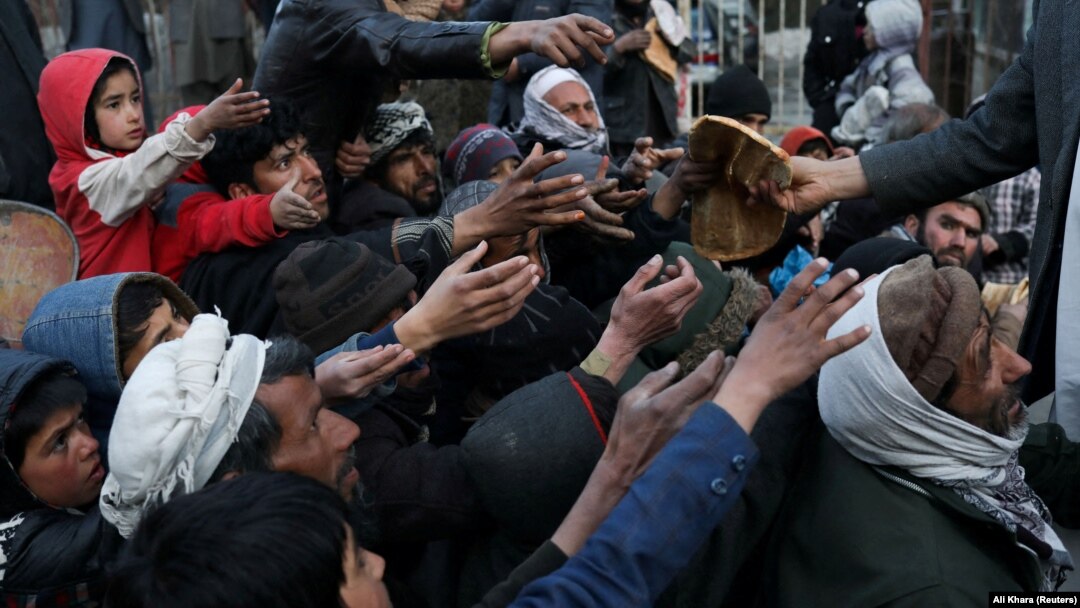Mahmood has been selling off what is left of his family’s meager possessions in order to prepare for the harsh winter ahead.
“I sold our carpets and kitchen utensils to buy food and fuel for the winter,” the father-of-five, who lives in the northern Afghan province of Parwan, told RFE/RL’s Radio Azadi.
Mahmood is among the millions of Afghans who aid groups say will struggle to survive as the country braces for its second winter under Taliban rule. There are fears that this winter could be even worse as hunger and disease spread and the prices of food and energy surge.
The Taliban’s takeover of Afghanistan in August 2021 triggered an economic collapse and worsened a major humanitarian crisis. Western donors abruptly cut off assistance and the new government was hit by international sanctions.
Aid groups have warned that the onset of winter will compound the acute humanitarian crisis in Afghanistan, where around 90 percent of people already do not have enough to eat.
Many Afghans are bracing for the worst. More and more people are selling their belongings to make ends meet.
Halima, a widow in the capital, Kabul, has already sold most of her family’s belongings to feed her five children. “The only things I haven’t sold are things that nobody will buy,” she told Radio Azadi.
Afghans who do not have possessions or employment have taken even more desperate steps. Some families have married off their underage daughters. Others have sold their kidneys or children in a bid to avoid starvation.
Your browser doesn’t support HTML5
Organs And Children Sold Amid Afghan Economic Collapse
Tapiwa Gomo, a spokesman for the United Nations Office for the Coordination of Humanitarian Affairs (OCHA), told RFE/RL that Afghan families are being forced to take “more and more severe coping strategies” as their finances deteriorate.
'A Step Away From Famine'
Martin Schuepp, director of operations at the Red Cross who visited Afghanistan last week, said Afghans face an “impossible choice” this winter: “to eat or to buy heat.”
“They can’t afford either, resulting in a frightening rise in malnutrition and pneumonia cases,” he said.
The Red Cross estimates that child malnutrition cases this year are 90 percent higher than in 2021, while pneumonia has risen by 55 percent during the same period.
“Lack of warm clothing, insulation, and heating heightens the risk of respiratory infections, hypothermia and preventable mortality among children and the elderly,” said Gomo.
Your browser doesn’t support HTML5
Afghan Hospital Sees Malnutrition Spike As UN Warns 875,000 Children At Risk
With many Afghans unable to afford food or heating, the number of people in need of humanitarian assistance has surged. According to the OCHA, more than 28 million Afghans need humanitarian assistance, a 16 percent increase from last year.
"Severity levels remain unprecedented, with 6 million people a step away from famine," said Gomo. "This is still one of the highest figures in the world in absolute terms."
Power Cuts
Many Afghans cannot afford gas, coal, wood, or fuel to cook and heat themselves. Those who rely on electricity, meanwhile, have been reeling from frequent and prolonged power cuts in recent weeks.
Uzbekistan, from where Afghanistan imports significant amounts of electricity, has cut its exports due to technical issues, sending prices soaring.
Afghan women carry firewood on their heads in Dara-i Noor district of Nangarhar Province. (file photo)
Fazal, a Kabul resident, said electricity is only available for a few hours each day, usually late at night.
Another Kabul resident, Bashir, said the rise in electricity prices has made it hard for him to make ends meet.
“I am struggling to pay for the high price of electricity while also coping with inflation,” he said.
Food prices have increased substantially compared to last year. The World Food Programme has said that the food basket it provides to vulnerable Afghans is 20 percent more expensive this year because of the global food and energy price hikes caused by the war in Ukraine.
"We are destitute, desperate, and need help," said Akbar who lives in the southeastern Paktia Province. Without assistance, he said, many in his village will not survive the winter.


